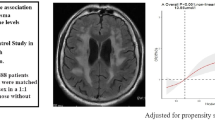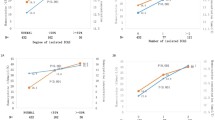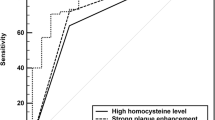Abstract
Intracranial aneurysms (IAs) are common lesions in the brain. There is a strong relation between hyperhomocysteinemia (HHcy) and cerebrovascular disease; we perform a retrospective study within the Chinese Han population to explore the association between HHcy and IAs. Two hundred six patients with IAs and 206 control subjects were evaluated for their serum total homocysteine levels. With multiple logistic regression analysis, the association between HHcy and the risk of IAs was estimated. Interaction and stratified analyses were conducted according to age, sex, BMI, smoking status, drinking status, and chronic disease histories. The threshold effect was examined by the two-piecewise linear regression model. The multivariate logistic regression analyses revealed a significant association between HHcy and IAs (odds ratio (OR) = 1.68; 95% confidence interval (CI), 1.02–2.75) after adjusting for classical vascular risk factors. And a 2% higher risk of IAs was observed, which was associated with a 1-μmol/L increase in serum total homocysteine level. The interaction analysis showed that age played an interactive role in the association between HHcy and IAs. In summary, our study provides evidence that HHcy is an independent risk factor for IAs in the Chinese Han population, especially in the elderly subgroup. Taking all the findings into consideration, longitudinal studies and clinical trials of homocysteine-lowering therapy via dietary or medical intervention are needed to assess the causal nature of these relationships.



Similar content being viewed by others
References
Vlak MH, Rinkel GJ, Greebe P, Algra A (2013) Independent risk factors for intracranial aneurysms and their joint effect: a case-control study. Stroke 44:984–987
Zhang LT, Wei FJ, Zhao Y, Zhang Z, Dong WT, Jin ZN, Gao F, Gao NN, Cai XW, Li NX, Wei W, Xiao FS, Yue SY, Zhang JN, Yang SY, Li WD, Yang XY (2015) Intracranial aneurysm risk factor genes: relationship with intracranial aneurysm risk in a Chinese Han population. Genet Mol Res 14:6865–6878
Sforza DM, Putman CM, Cebral JR (2009) Hemodynamics of cerebral aneurysms. Annu Rev Fluid Mech 41:91–107
Aoki T, Kataoka H, Morimoto M, Nozaki K, Hashimoto N (2007) Macrophage-derived matrix metalloproteinase-2 and -9 promote the progression of cerebral aneurysms in rats. Stroke 38:162–169
Fukuda S, Hashimoto N, Naritomi H, Nagata I, Nozaki K, Kondo S, Kurino M, Kikuchi H (2000) Prevention of rat cerebral aneurysm formation by inhibition of nitric oxide synthase. Circulation 101:2532–2538
Hazama F, Kataoka H, Yamada E, Kayembe K, Hashimoto N, Kojima M, Kim C (1986) Early changes of experimentally induced cerebral aneurysms in rats. Light-microscopic study. Am J Pathol 124:399–404
Kondo S, Hashimoto N, Kikuchi H, Hazama F, Nagata I, Kataoka H (1998) Apoptosis of medial smooth muscle cells in the development of saccular cerebral aneurysms in rats. Stroke 29:181–188 discussion 189
Tamura T, Jamous MA, Kitazato KT, Yagi K, Tada Y, Uno M, Nagahiro S (2009) Endothelial damage due to impaired nitric oxide bioavailability triggers cerebral aneurysm formation in female rats. J Hypertens 27:1284–1292
Eberhardt RT, Forgione MA, Cap A, Leopold JA, Rudd MA, Trolliet M, Heydrick S, Stark R, Klings ES, Moldovan NI, Yaghoubi M, Goldschmidt-Clermont PJ, Farber HW, Cohen R, Loscalzo J (2000) Endothelial dysfunction in a murine model of mild hyperhomocyst(e)inemia. J Clin Invest 106:483–491
Weiss N, Heydrick S, Zhang YY, Bierl C, Cap A, Loscalzo J (2002) Cellular redox state and endothelial dysfunction in mildly hyperhomocysteinemic cystathionine beta-synthase-deficient mice. Arterioscler Thromb Vasc Biol 22:34–41
Arapoglou V, Kondi-Pafiti A, Rizos D, Kotsis T, Kalkandis C, Katsenis K (2009) The influence of total plasma homocysteine and traditional atherosclerotic risk factors on degree of abdominal aortic aneurysm tissue inflammation. Vasc Endovasc Surg 43:473–479
Bhargava S, Ali A, Manocha A, Kankra M, Das S, Srivastava LM (2012) Homocysteine in occlusive vascular disease: a risk marker or risk factor. Indian J Biochem Biophys 49:414–420
Halazun KJ, Bofkin KA, Asthana S, Evans C, Henderson M, Spark JI (2007) Hyperhomocysteinaemia is associated with the rate of abdominal aortic aneurysm expansion. Eur J Vasc Endovasc Surg 33:391–394 discussion 395-396
Manolescu BN, Oprea E, Farcasanu IC, Berteanu M, Cercasov C (2010) Homocysteine and vitamin therapy in stroke prevention and treatment: a review. Acta Biochim Pol 57:467–477
Ren JR, Ren SH, Ning BWJ, Cao Y, Ding XM, Zhen ZG, Hao XD, Wang S (2017) Hyperhomocysteinemia as a risk factor for saccular intracranial aneurysm: a cohort study in a Chinese Han population. J Stroke Cerebrovasc Dis 26:2720–2726
Liu J, Zuo SW, Li Y , Jia X, Jia SH, Zhang T, Song YX, Wei YQ, Xiong J, Hu YH, Guo W (2016) Hyperhomocysteinaemia is an independent risk factor of abdominal aortic aneurysm in a Chinese Han population. Sci Rep 6:17966
Wei Y, Xiong J, Zuo S, Chen F, Chen D, Wu T, Guo W, Hu Y (2014) Association of polymorphisms on chromosome 9p21.3 region with increased susceptibility of abdominal aortic aneurysm in a Chinese Han population. J Vasc Surg 59:879–885
Zhu C, Wang X, Degnan AJ, Shi Z, Tian B, Liu Q, Hess C, Saloner D, Lu J (2018) Wall enhancement of intracranial unruptured aneurysm is associated with increased rupture risk and traditional risk factors. Eur Radiol 28:5019–5026
McCully KS (1969) Vascular pathology of homocysteinemia: implications for the pathogenesis of arteriosclerosis. Am J Pathol 56:111–128
Iso H, Moriyama Y, Sato S, Kitamura A, Tanigawa T, Yamagishi K, Imano H, Ohira T, Okamura T, Naito Y, Shimamoto T (2004) Serum total homocysteine concentrations and risk of stroke and its subtypes in Japanese. Circulation 109:2766–2772
Møller J, Nielsen GM, Tvedegaard KC, Andersen NT, Jørgensen PE (2000) A meta-analysis of cerebrovascular disease and hyperhomocysteinaemia. Scand J Clin Lab Invest 60:491–499
Xu Y, Tian Y, Wei HJ, Dong JF, Zhang JN (2011) Methionine diet-induced hyperhomocysteinemia accelerates cerebral aneurysm formation in rats. Neurosci Lett 494:139–144
Harker LA, Ross R, Slichter SJ, Scott CR (1976) Homocystine-induced arteriosclerosis. The role of endothelial cell injury and platelet response in its genesis. J Clin Invest 58:731–741
Harker LA, Slichter SJ, Scott CR, Ross R (1974) Homocystinemia. Vascular injury and arterial thrombosis. N Engl J Med 291:537–543
Kojima M, Handa H, Hashimoto N, Kim C, Hazama F (1986) Early changes of experimentally induced cerebral aneurysms in rats: scanning electron microscopic study. Stroke 17:835–841
Tulamo R, Frösen J, Hernesniemi J, Niemelä M (2010) Inflammatory changes in the aneurysm wall: a review. J Neurointerv Surg 2:120–130
Lee M, Hong KS, Chang SC, Saver JL (2010) Efficacy of homocysteine-lowering therapy with folic acid in stroke prevention: a meta-analysis. Stroke 41:1205–1212
Mohan IV, Adam DJ, Kurian KM, Ruckley CV (1997) Isolated external iliac aneurysm associated with hyperhomocysteinaemia. Eur J Vasc Endovasc Surg 14:506–508
Wong A, Naik M, Chan C, Chua YL, Chua T (2001) Giant coronary aneurysms with multiple vascular aneurysms: a rare manifestation of hyperhomocysteinemia. Catheter Cardiovasc Interv 52:116–119
Sources of funding
This study has been supported by the Hainan Provincial Natural Science Foundation of China (grant number 818QN321).
Author information
Authors and Affiliations
Contributions
The scientific guarantor of this publication is BaiNan Xu, Ph.D. Kai Zhao has significant statistical expertise. And we want to thank the invaluable support recieved from Jie Liu, who gave us the great motivation to carry out this work.
Corresponding author
Ethics declarations
Conflict of interest
The authors declare that they have no conflict of interest.
Ethical approval and informed consent
Institutional review board approval and written informed consent were obtained.
Additional information
Publisher’s note
Springer Nature remains neutral with regard to jurisdictional claims in published maps and institutional affiliations.
Rights and permissions
About this article
Cite this article
Wang, Q., Zhang, J., Zhao, K. et al. Hyperhomocysteinemia is an independent risk factor for intracranial aneurysms: a case-control study in a Chinese Han population. Neurosurg Rev 43, 1127–1134 (2020). https://doi.org/10.1007/s10143-019-01138-9
Received:
Revised:
Accepted:
Published:
Issue Date:
DOI: https://doi.org/10.1007/s10143-019-01138-9




